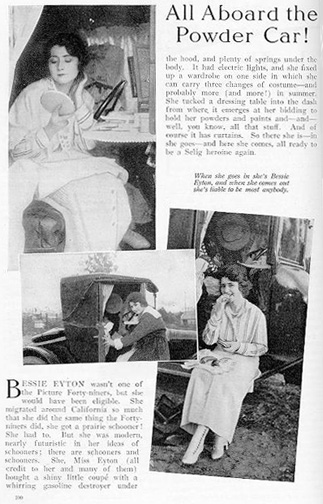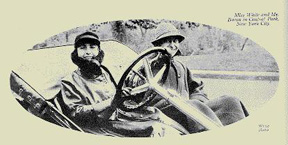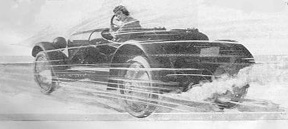| Besides the fan and trade press, there were numerous stories in the Sunday motoring sections of the large newspapers about the stars and their cars. When in March of 1915, Bessie Eyton, the popular Selig star of such hits as The Spoilers (1914) and The Crisis (1916), drove up to San Francisco to see the San Francisco Exposition, The San Francisco Chronicle ran a story about it, an article which also indicates the state of many roads at that time: |
| |
"Bessie Eyton, the auburn-haired beauty of the motion-picture world, who has carried many a feature to fame by her daring stunts, enjoyed a vacation last week by performing as daring a feat as any she has undertaken in her screen career. fame by her daring stunts, enjoyed a vacation last week by performing as daring a feat as any she has undertaken in her screen career.
With rain falling in Los Angeles and at a time when she was told on all sides that the roads were absolutely impassable, she started for the San Francisco exposition in her Paige touring-car and successfully negotiated the trip up the valley in three days.
She drove the car the entire distance herself, being accompanied by Mr. and Mrs. I. O. Parsons and Mrs. Ada Hanson. Miss Eyton was the only member of the party with the least motor car experience, and if there had been any tire changing or work on the car the bulk of it would have fallen upon her. But the Paige was faithful to its trust, and there was no hesitating on the long, hard trip.
The party reached San Francisco Thursday, and, after three days at the exposition, Miss Eyton returned by train as work is to start at once on a big six-reel feature in which Miss Eyton will be featured.
Bessie Eyton is typical of the rise of the motion picture. She is a young girl whose acting experience has been confined entirely to the picture world. She is unique in that she is not only a pretty, dainty actress, but in pictures that require daring rides on racing horses before a herd of stampeding buffalo, dives from decks of ocean liners or dangerous drives over mountain roads at the wheel of a motor car she refuses to have anyone double for her. She is clever in her soft work and glorious in her outdoor daring. Those who saw The Spoilers will remember her dive from the deck of the Alaskan vessel. She played the leading feminine role in that picture and really made the dive as pictured.
So to her the driving of a motor car from Los Angeles to San Francisco when the roads were considered impassable was not a feat to make her hesitate.
The worst part of the trip was encountered during the first hundred miles out of Los Angeles. Fifty miles from Los Angeles she began encountering bad mud holes. The Bouquet canyon road was almost impassable in places but by hitting the bad places she managed to pilot the Paige through to Elizabeth Lake. Here the party experienced a snowstorm, but even this did not stop them and they continued on their way to Willow Springs. This proved the hardest part of the trip, and for thirty miles it was a question almost every minute whether or not they would get any further.
There had been a heavy rain the night before and for miles the country was little more than a bog. The car was in mud and water up to the hubs for mile after mile, and members of the party urged her to turn back, but turning back is not Bessie Eyton's nature, and she kept the car plugging ahead and at dusk was rewarded by the lights of Mojave ahead.
From there on they encountered some bad places, but, after getting through the snow at the summit of the Tehachapi grade, she made good progress. The second night's stop was made at Fresno, and from there on the trip was an easy one.
Miss Eyton was truly home when she reached San Francisco, as she was born in the Golden Gate city."(43) |
 No actress was more enamoured of driving than Pearl White. Off-screen, Pathe's scintillating "Peerless, Fearless Girl" was an ardent suffragette, warm-hearted, high-spirited and very independent, the kind of woman who revelled in the new mode of transportation. Every romance has its periods of disillusionment, however, and at the time she made The Perils of Pauline in 1914, Pearl was still shaken by the accident involving the cameraman a few months before when she had been working for the Crystal Company. When Mabel Condon interviewed her for Photoplay Magazine in 1914, she said that cars had "lost their attraction for me as a novelty, and I dislike the fast ones especially" because of the mishap during filming. Pearl continued: No actress was more enamoured of driving than Pearl White. Off-screen, Pathe's scintillating "Peerless, Fearless Girl" was an ardent suffragette, warm-hearted, high-spirited and very independent, the kind of woman who revelled in the new mode of transportation. Every romance has its periods of disillusionment, however, and at the time she made The Perils of Pauline in 1914, Pearl was still shaken by the accident involving the cameraman a few months before when she had been working for the Crystal Company. When Mabel Condon interviewed her for Photoplay Magazine in 1914, she said that cars had "lost their attraction for me as a novelty, and I dislike the fast ones especially" because of the mishap during filming. Pearl continued: |
| |
"The car I owned then was a seven-passenger one; it was the first one I ever had and I bought the biggest I could get. I always had it full of friends and I speeded and used thousands of gallons of juice. But I'm through with that one and the one I'm getting now is going to be a two-passenger. And I'll drive it so slowly that, instead of being arrested for speeding, the charge will be blocking the traffic."(44) |
|
But Pearl's resolve to ease up on the accelerator proved to be fleeting indeed. In 1915, she was engaged in filming The Romance of Elaine, the follow-up to The Exploits of Elaine and The New Exploits of Elaine, at the Wharton Brothers' new Renwick Park studio in Ithaca, New York. During a break in the filming, Pearl bought a new yellow Stutz Bearcat which became her passion. She was a familiar sight around Ithaca and neighboring towns as she zoomed around the countryside in her Stutz. Once when with lightheart and leadfoot she entered nearby Trumansburg, she was fined five dollars for speeding. Instead, she paid ten dollars because, as she told the village peace justice, "I'm leaving your goddamned town as fast as I came in!' (45)
On a fall afternoon in New York City in 1915, George Vaux Bacon interviewed Pearl for the cover article in Photoplay. Most of the interview took place as Pearl drove Bacon around Manhattan in her Stutz, "a yellow roadster, of long, low rakish lines.' (46) The article gives a vivid impression of Pearl at the height of her career when she was the most famous film star in the world, so beloved that traffic policemen in Manhattan gave her the right of way. "With a brown velour hat over her red hair, clad in a brown norfolk suit and tan shoes, and with eyes of changing green and hazel shades,' Pearl "in that best-known of all roadsters in the environs of Manhattan" (47) had started with the writer from the Hotel Astor where she then lived. Still affected by her fall downstairs during the filming of The Perils of Pauline, an injury which would plague her in later years, Pearl spent an hour with an osteopath at the Hotel Martinique while Bacon waited in the barroom. Bacon wrote: |
| |
"On her reappearance, jaunty and smiling in her tan ensemble (which is extremely becoming to her), the car was cranked with a shove of her tan boot on the automatic starter, and the yellow car with its stellar and journalist occupants, shot through Thirty-third Street . . . to Fifth Avenue, and northwards thereon towards Central Park. . .
Elaine is a cracker-jack of a driver. She threaded her way through the traffic with little spurts of speed here, and sudden slowings up there; with an ease and cleverness to awaken the admiration of the most demoniac taxi driver in New York. And as we sped in and out, from bus-top and limousine, from Ford and Rolls-Royce, came continuously:
'Look! There's Pearl White!'
And she didn't notice one of them. Not she! She was too busy driving.
When we made Fifty-ninth Street and debouched into the smooth, glistening Park drives, she began to talk.
'I've only driven this car seven thousand miles,' said she. 'It's a new one. I got it at the beginning of my vacation in the middle of July. I turn in my old car and get a new one every six months instead of every year or two. I find that it is less expensive in the long run, and as a result, I always have a car that is fresh and new and up to the mark. Also, I always get better value for the car I turn in.
'I got this car just before I went on my vacation. Incidentally, I took my vacation alone, driving the car from New York to Buffalo and back.'
'What?' I asked . . . after all, it is some five hundred miles from New York to Buffalo. . . .
'Sure,' she replied. "I had the time of my life. I had been working through a straight session of fifty-two weeks from sunrise to sunset in the studios, and I felt that I needed a good rest and a real one. I took it. A rest to me means being alone. At night I slept under the car in somebody's corn field most of the time.'
'Very good, Eddie!' I reproved subtly.
'Oh, you don't believe me?' She flashed me a quick look with the careless, good-natured yet indubitably scrappy, red-headed smile, which is the key to the character of the real Pearl White. "I certainly did it,' she reiterated, "and I had the time of my life. I could have fought my weight in wild cats at the end of the trip.'"(48) |
|
| As Pearl and Bacon glided through Central Park, she recounted her Missouri background and early career. |
| |
"She finished her narrative and we arrived at the north end of the Park at the same time. We had taken the eastern drive, and turned to go out onto One Hundred and Tenth Street towards Riverside Drive. As we emerged from the bosky recesses, a crowd of small boys greeted us with:
'Aw, chee, look! Dere goes Poil White!'
And we did! Up the One Hundred and Tenth Street hill towards Broadway at a fifty-mile clip. When they raise them red-headed out in Missouri, it means something."(49) |
|
| They were shooting down a long hill towards the Seventies with the Hudson inview when Pearl "put her foot on the exhilirator. The needle of the speedometer leaped ten degrees. A policeman at a crossing grinned indulgently. The green scarab in his bed of woven gold gleamed royally on the small hand gripping the big steering-wheel. (50) |
| |
"A long, low white yacht became visible in the river.
'I took my first picture on the deck of that yacht,' she remarked casually. 'The deck is fifteen feet above the water line. I dived from it. It's an easy life, isn't it?'
'Apparently,' I remarked.
'Where do you want to go now?' she asked.
'Well,' I said, 'when we started out, I thought we might run up through Yonkers along the Hudson towards Tarrytown for a ways. It's a beautiful drive.'
'Can't go through Yonkers,' she said calmly. 'I was arrested there twice last month for speeding.'
That's why we didn't go to Yonkers. The policemen there don't seem to go to the movies.
Instead, we went back to the Astor and sat around in the Orange Room for two hours, talking about the autobiography which Miss White is writing. . . . and about motor races and hair-breadth 'scapes."(51) |
|
Pearl became so attached to her yellow Stutz that she drove it for years. It was one of her trademarks; in 1919, for example, The Dramatic Mirror ran a photo with this caption: "Pearl White leaving her Bayside, L.I. home in her famous yellow Stutz to appear before the camera photographing The Lightning Raider (Pathe).' (52)
Pearl, of course, often drove cars in her films including her final one, Terror, filmed in France in 1923 and released the following year. The only film she made in Europe, Terror contains scenes with her driving racing cars through the streets of Paris and over the hilly French countryside. Terror was a big hit in France, running for three months in one Paris theater. Pearl, now the most idolized actress in France, soon became as familiar a sight in Paris driving a big white racing car as she had been in New York piloting her yellow Stutz. (53) At the time Pearl made Terror, it was still rare for women on the Continent to drive. But now with the examples of Pearl and other American film actresses on the screen, it suddenly became more chic by the mid-twenties for an increasing number of European women to drive. And as had been true in the United States, the film actresses on the Continent were among the first prominent women to take the wheel, receiving a great deal of publicity for their motoring exploits in the process. |
 fame by her daring stunts, enjoyed a vacation last week by performing as daring a feat as any she has undertaken in her screen career.
fame by her daring stunts, enjoyed a vacation last week by performing as daring a feat as any she has undertaken in her screen career. No actress was more enamoured of driving than Pearl White. Off-screen, Pathe's scintillating "Peerless, Fearless Girl" was an ardent suffragette, warm-hearted, high-spirited and very independent, the kind of woman who revelled in the new mode of transportation. Every romance has its periods of disillusionment, however, and at the time she made The Perils of Pauline in 1914, Pearl was still shaken by the accident involving the cameraman a few months before when she had been working for the Crystal Company. When Mabel Condon interviewed her for Photoplay Magazine in 1914, she said that cars had "lost their attraction for me as a novelty, and I dislike the fast ones especially" because of the mishap during filming. Pearl continued:
No actress was more enamoured of driving than Pearl White. Off-screen, Pathe's scintillating "Peerless, Fearless Girl" was an ardent suffragette, warm-hearted, high-spirited and very independent, the kind of woman who revelled in the new mode of transportation. Every romance has its periods of disillusionment, however, and at the time she made The Perils of Pauline in 1914, Pearl was still shaken by the accident involving the cameraman a few months before when she had been working for the Crystal Company. When Mabel Condon interviewed her for Photoplay Magazine in 1914, she said that cars had "lost their attraction for me as a novelty, and I dislike the fast ones especially" because of the mishap during filming. Pearl continued: